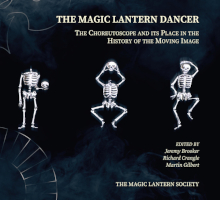Price £25.00 (£20.00 to MLS members)
Jeremy Brooker, Richard Crangle and Martin Gilbert (eds), The Magic Lantern Dancer: The Choreutoscope and its Place in the History of the Moving Image
London: Magic Lantern Society, 2023
ISBN 978-0-9929628-1-4
148 pages, 160 illustrations, paperback, 24 x 22cm

The choreutoscope (pronounced cory-ute-o-scope – the name is based on ancient Greek, meaning ‘dancer viewer’) was a complex mechanical device used in a magic lantern to change quickly between images, giving a projected illusion of basic movement and often used to portray dancing characters or skeletons. Devised in Britain in the late 1860s, it was used in several different forms throughout Europe and the United States for the rest of the 19th century.
Part 1 of the book gives a detailed account of the choreutoscope’s history and development, including its true inventor, its uses in institutions like the Royal Polytechnic, the different variants of its design and its relationships to the origins of cinematography. Part 2 complements this with a richly illustrated survey of surviving choreutoscope mechanisms and slides now in the collections of MLS members and major international institutions. With over 160 illustrations and drawing on the latest research findings, this is the first book to reveal the true story of this ingenious device and its place in the history of visual culture.
